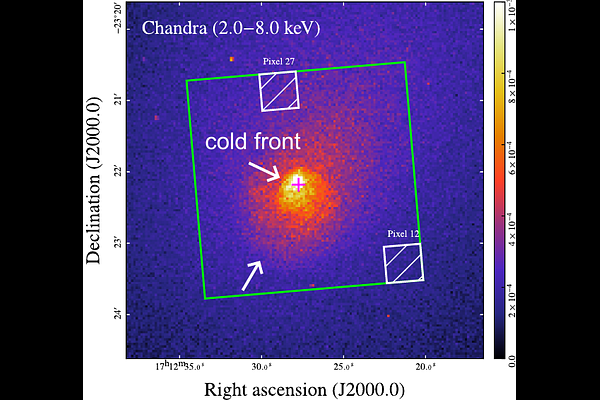XRISM Observation of the Ophiuchus Galaxy Cluster: Quiescent Velocity Structure in the Dynamically Disturbed Core

XRISM Observation of the Ophiuchus Galaxy Cluster: Quiescent Velocity Structure in the Dynamically Disturbed Core
Yutaka Fujita, Kotaro Fukushima, Kosuke Sato, Yasushi Fukazawa, Marie Kondo
AbstractWe present the high-resolution X-ray spectroscopic observations of the Ophiuchus galaxy cluster core using the XRISM satellite. Despite previous observations revealing multiple cold fronts and dynamical disturbances in the cluster core, our XRISM observations show low gas velocity dispersions of \sigma_v = 115 +/- 7 km s^{-1} in the inner region (~< 25 kpc) and \sigma_v = 186 +/- 9 km s^{-1} in the outer region (~ 25-50 kpc). The gas temperatures are kT = 5.5 +/- 0.2 keV and 8.4 +/- 0.2 keV for the inner and outer regions, respectively, with metal abundances of Z = 0.75 +/- 0.03 Z_sun (inner) and 0.44 +/- 0.02 Z_sun (outer). The measured velocity dispersions correspond to nonthermal pressure fractions of only 1.4 +/- 0.2% (inner) and 2.5 +/- 0.2% (outer), indicating highly subsonic turbulence. Our analysis of the bulk gas motion indicates that the gas in the inner region is nearly at rest relative to the central galaxy (|v_bulk|=8 +/- 7 km s^{-1}), while the outer region exhibits a moderate motion of |v_bulk|=104 +/- 7 km s^{-1}. Assuming the velocity dispersion arises from turbulent motions, the turbulent heating rate is only ~ 40% of the radiative cooling rate, although there is some uncertainty. This suggests that the heating and cooling of the gas are not balanced. The activity of the central active galactic nucleus (AGN) has apparently weakened. The sloshing motion that created the cold fronts may now be approaching a turning point at which the velocity is minimum.